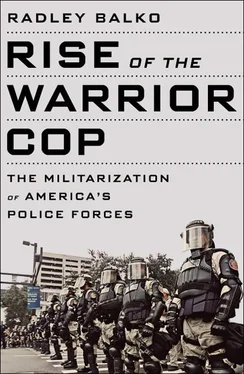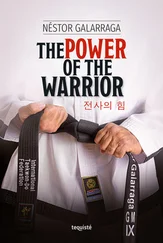The house then went silent. McCarthy made fifteen more announcements, all to no avail. Gates decided to move with the SWAT team.
The SWAT team opted first for tear gas. The SLA responded with gunfire from a Browning automatic rifle. Gates then heard over the radio that the SWAT team was asking for fragmentation grenades. Interestingly, this alarmed him.
Jesus, I thought. We didn’t have fragmentation grenades. Used only by the military, they explode into body-piercing shards….
Fragmentation grenades are not funny. They are meant to seriously injure people. The SWAT request was made to John McAllister, the field commander. I picked up the microphone in my car and butted in. “You do not have permission to use fragmentation grenades,” I said—in effect telling John what his decision should be.
Had I been able to see firsthand what was going on, maybe I would have called the military, made the request. But instinctively, I didn’t like a civil police force using a weapon designed for an army . 83
Again, it’s illuminating just how different attitudes were then than they are today. Here a heavily armed terrorist group had just opened fire in downtown Los Angeles. And we have Gates—the foremost proponent of militarized policing of his era—reflecting back on the incident, remembering that even under those circumstances, he had serious reservations about using military weapons against civilians.
When Gates arrived near the scene of the shoot-out, he saw the same sort of urban battlefield he’d seen during the Watts riots. “Here in the heart of Los Angeles was a war zone, something out of a World War II movie,” he writes, “where you’re taking the city from the enemy, house by house.”
Minutes later, a dazed woman named Christine Johnson emerged from the house. She was one of the tenants before the SLA moved in. A SWAT officer ushered her away from the gunfire.
After about fifty minutes of heavy gunfire between the SLA and SWAT officers, the house caught fire. McCarthy again pulled up his bullhorn and offered to let the occupants surrender. The SLA responded with more gunfire. The fire raged on. There was little anyone could do. Understandably, LA firefighters wanted nothing to do with the blaze. They couldn’t get close enough to douse it with water without making themselves vulnerable to gunfire.
Two women did eventually emerge from the rear of the house. Both were shot dead by police. (LAPD officers claimed the women emerged firing guns. Investigators hired by the women’s families later claimed they were unarmed.)
The rest of the SLA remained inside as the building burned to the ground. Six more SLA members died, either from being shot, from suicide, or from the fire, including Cinque, the group’s leader. Between them, the SLA and LAPD fired more than nine thousand rounds of ammunition.
Patty Hearst wasn’t in the building. She’d later be arrested, charged, and convicted for her role in the bank robbery. She claims she had been brainwashed, beaten, and sexually abused by SLA members. The jury apparently didn’t find her sympathetic, but her sentence was later commuted by President Jimmy Carter, and President Bill Clinton granted her a pardon in 2001, one of his last acts in office.
Ironically, the most enduring legacy of the SLA—an organization that seemed to see fascism just about everywhere—was to promote, popularize, and facilitate the spread of SWAT teams across America. For Gates, it was the perfect confluence of events. The SLA had attracted national attention when it kidnapped Hearst. The standoff with the LAPD and the FBI was not the result of a quick response to a bank robbery or mass shooting. It came after a full day of news reports that the group was in the city and law enforcement was in the process of tracking them down. That put news teams at the ready, so when it broke that the SLA had been located, they were prepped to send cameras and reporters. Gates, who mostly had an antagonistic relationship with the press, wryly notes in his book that as the gunfire dragged on, “I was briefly amused to notice that the hordes of reporters who had by now materialized were actually keeping their distance—for the only time I can remember.”
They may have steered well clear of the flying bullets, but Gates certainly benefited from their presence. Live video of the gunfight was broadcast across the city. The footage then went nationwide. Gates’s pet project, now eight years in the making, had finally found a national spotlight.
If the mission of Gates’s SWAT teams was to quickly defuse a violent situation with minimal casualties, the confrontation with the SLA was far from an unqualified success. The team’s decisions in the field had again led to a protracted exchange of thousands of rounds of gunfire in the middle of a densely populated urban area, not to mention a huge house fire and several deaths. But all of the deaths were SLA members. No police officers and no citizens outside the group suffered any significant injuries. And unlike the Black Panther raid, in which it could be argued that the police provoked a radical group that had some propensity for violence but for whom violence wasn’t the primary objective, the SLA radicals had been violent from the start. Violence was the means of the group’s activism. It had recently committed violent acts, and gave every indication it would continue to do so in the near future. There was no provocation here. Even if the tactics themselves yielded less than optimal results, there was no question that a police agency charged with protecting the city had no choice but to confront the group once they learned of its location.
After the shoot-out, the LAPD was flooded with letters, as were city newspapers. The letters ran about five-to-one in favor of the police, with praise for the SWAT teams in particular. Chris McNab, a prolific author of books on police and the military, writes that after the SLA shoot-out, “SWAT was now on the public map, most viewers being enthralled by its toughness, others being appalled.” 84
Gates himself writes:
One thing was certain. That night, SWAT became a household word throughout the world. They were intrepid; they were brilliant in their deployment; their execution was flawless. Soon, other law enforcement agencies began mounting their own SWAT teams. The whole nation had watched the shootout—live, on network TV.
He concludes, “Clearly, SWAT had arrived.” 85
EARLY IN THE MORNING OF FEBRUARY 24, 1975, OFFICER Robert Duran and his partner, Officer Jim Street, were cruising in their squad car. A call came in about a potentially violent domestic disturbance. “Lovely,” Duran said. “They’re at each other’s throats already.” He pulled the car up to the intersection of the reported dispute. Nothing to speak of. “Quiet as a tomb,” Duran said, forebodingly. “Are you sure we got the right number?” The next day would be Duran’s birthday. His pretty wife was pregnant with their third child. All was right with the world. Then a shot rang out. Then several more. The two officers were caught in a deadly triangle of three snipers. Duran went down.
Street held the snipers at bay until the SWAT team could arrive. But by the time SWAT captain Hondo Harrelson and his team could scramble to the scene and ascend to the rooftop where one of the snipers was perched, all three gunmen had already left their positions and met back up on the street. Harrelson could only watch in anger as the assassins hopped into a gold Ford Maverick and sped away.
Sgt. Deacon Kay jooined his colleagues on the rooftop.
“The call was a phony, just like all the others,” Kay said to Harrelson. “Ambush. Cold-blooded assassins. But why? ”
Читать дальше













